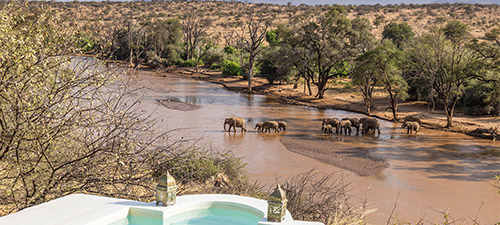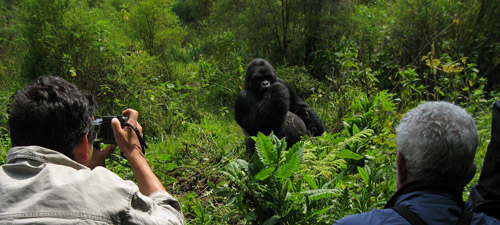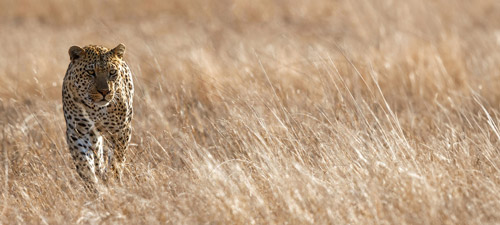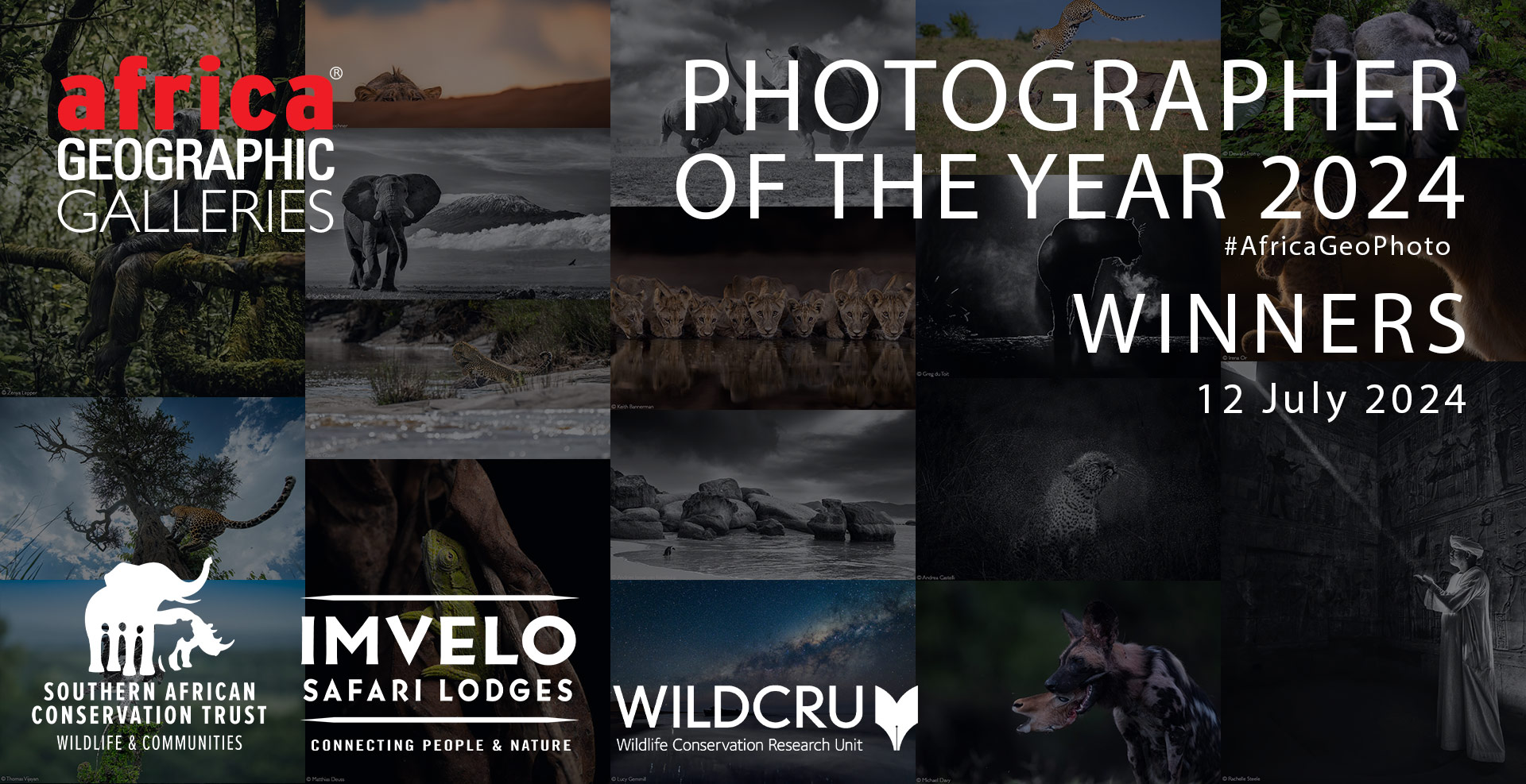
Photographer of the Year 2024 Winners


And the winner is…. After careful consideration and much deliberation, we are pleased to announce the results for Photographer of the Year 2024. These talented photographers have captured the essence of Africa through their lenses, resulting in a powerful mix of photographs.
We want to thank our generous sponsors, Imvelo Safari Lodges, and associates Southern African Conservation Trust (SACT) and WILDCRU. Their support has been invaluable.
Each of the three winners (the overall winner and two runners-up) will become a personal sponsor of a wild Hwange lion research collar. Winners and their partners will join our CEO Simon Espley on a conservation safari in Botswana. Read more about the Photographer of the Year 2024 prizes here.
A note from our CEO
How we agonised over this final selection!
What truly stood out for us this year was the unique and diverse biodiversity reflected in the entries – from grand landscapes and iconic mammals that rule their kingdoms to avian candy and fascinating insects. This year’s winners and highly commended photos are a stunning reflection of the incredible beauty of this continent we call home and a testament to their exceptional skills.
For some reason, this year, more leopard and lion photos made it into the final selection. Every year brings a new theme – this is an organic process that we have no influence over. What a joy it was to watch these outstanding entries fill our inbox every day!
Of course, artificial intelligence (AI) is now commonplace during post-production editing, and we can see that beneficial impact when comparing the RAW photographic files to these photos. Importantly, we do not permit any images generated via AI.
Congratulations to every entrant who made it through thousands of entries to appear in our weekly selections, Top 105, Finalists, and these Winners. Thanks for sharing your beautiful work with us and trusting us to honour and recognise you. In this modern world of cheap imitations and instant gratification, these entries stand out as reflecting our core value system, which is driven by authenticity and time invested.

Simon Espley – CEO, Africa Geographic
WINNER – PHOTOGRAPHER OF THE YEAR 2024
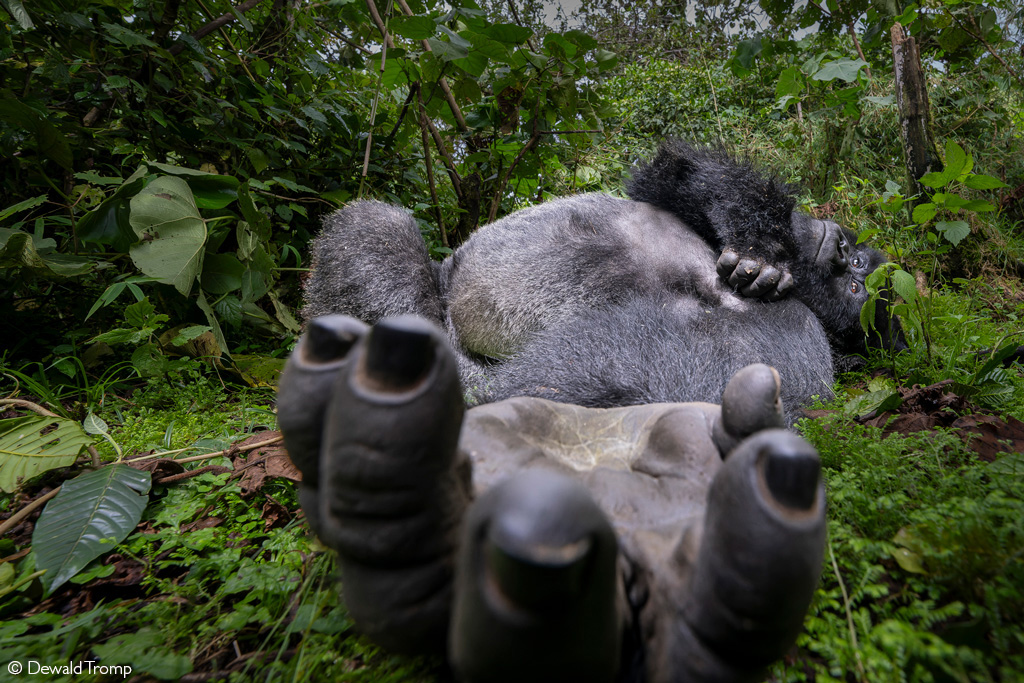
Judges’ comment:
This gorilla’s beckoning gesture and relaxed demeanour invite a rare glimpse into his world. Dewald’s winning photograph captures a unique and significant moment of intimacy between two great apes. The silverback’s initiation of the close encounter adds a distinct and impactful element to this moment. Dewald would’ve needed to keep his composure in the midst of an unnerving moment. Maintaining his focus on the gorilla’s eyes, while allowing its hand to dominate the photograph, gives an added dimension to the photograph.
Photographer and photo details – read more
Dewald says: “Conservation of the critically endangered mountain gorillas in Rwanda is one of the rare success stories in Africa and serves as a beacon of hope for the rest of the continent. More than 1,000 individuals remain in the rainforests bordering Rwanda, Uganda and the DRC. While I was trekking for mountain gorillas in Volcanoes National Park, the dominant silverback casually flopped down directly in front of me, observing his reflection in the lens of my camera. Surrounded by thick vegetation, I had nowhere else to go. I kept a submissive posture with my eyes downcast. He stretched out his hand to touch his reflection in the lens, and for the briefest moment, I imagined him extending his hand to greet me as an old friend. A moment in time that will stay with me for the rest of my life.”
About photographer Dewald Tromp
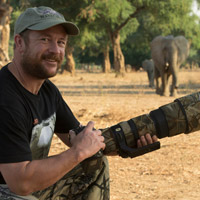 Originally from Windhoek, Namibia, Dewald grew up in the small rural town of Belfast, Mpumalanga. As a child, all his family holidays were spent camping or hiking in the Kruger National Park. This is where his love for nature was cultivated. Although he works in the medical field, wildlife photography has been his passion for the last 20 years. Dewald and his wife have travelled extensively around the globe to photograph rare and exciting wildlife. Through his images, he wants to influence people to start thinking about conservation and protecting the last remaining wild places on Earth.
Originally from Windhoek, Namibia, Dewald grew up in the small rural town of Belfast, Mpumalanga. As a child, all his family holidays were spent camping or hiking in the Kruger National Park. This is where his love for nature was cultivated. Although he works in the medical field, wildlife photography has been his passion for the last 20 years. Dewald and his wife have travelled extensively around the globe to photograph rare and exciting wildlife. Through his images, he wants to influence people to start thinking about conservation and protecting the last remaining wild places on Earth.
Social: dewald.tromp.9
RUNNERS-UP
(in no specific order)

Judges’ comment:
Ivan’s patience resulted in this exceptional capture of an exhilarating moment as the mother leopard ferries her tiny bundle across the river. We can only speculate why she would run the crocodile gauntlet of a river crossing – adding to the allure of this intimate image. Maintaining a well composed image in a moment that took mere seconds requires skill and a steady hand.
Photographer and photo details – read more
Ivan says: “I waited 10 hours to get this shot while in Maasai Mara National Reserve, Kenya. My guide, Shaddy Tira from Oltepesi Tented Safari Camp, and I knew the leopard known as Bahati had hidden her cubs in a den alongside a river a few days before. We felt there was a high chance she would be moving them to a new den soon. We also knew that Bahati was not in the den with the cubs and that she would at least have to return to the den soon to nurse them. We parked in the river crossing about 70m from the den and waited. Seven hours passed, but Bahati never appeared. We had to return to camp as it was getting dark. We returned first thing the next morning and determined through listening to the cubs calling that they were still in the den, and that Bahati had not yet returned. We waited another three hours before Bahati suddenly appeared, jumping across the river from the other side to get to the den. After briefly nursing her cubs, she gently picked them up in her mouth and carried them across the river, one by one. It was a moment I will never forget.”
About photographer Ivan Glaser
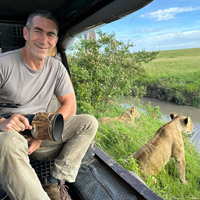 Ivan was born into a family of wildlife and photography enthusiasts in South Africa, where his deep passion for African wildlife and wildlife photography took root at an early age. Sharing this passion through his photography has always brought him joy. In his mid-twenties, Ivan emigrated to Australia and began his corporate career. During those years, his focus shifted away from wildlife and photography as his professional responsibilities and family took precedence. However, in 2019, an extraordinary opportunity presented itself when Ivan joined an Africa Geographic photo safari to the Maasai Mara National Reserve. Under the expert guidance of renowned Norwegian wildlife photographer Arnfinn Johansen and in the welcoming embrace of Oltepesi Tented Safari Camp, Ivan’s wildlife photography skills were radically transformed, and his love for Africa was reaffirmed. Now in retirement, he is wholeheartedly pursuing his lifelong passion for wildlife and wildlife photography by making regular trips back to the Maasai Mara, hosting guided photo safaris for small groups of fellow wildlife and photography enthusiasts who share his love for the natural world.
Ivan was born into a family of wildlife and photography enthusiasts in South Africa, where his deep passion for African wildlife and wildlife photography took root at an early age. Sharing this passion through his photography has always brought him joy. In his mid-twenties, Ivan emigrated to Australia and began his corporate career. During those years, his focus shifted away from wildlife and photography as his professional responsibilities and family took precedence. However, in 2019, an extraordinary opportunity presented itself when Ivan joined an Africa Geographic photo safari to the Maasai Mara National Reserve. Under the expert guidance of renowned Norwegian wildlife photographer Arnfinn Johansen and in the welcoming embrace of Oltepesi Tented Safari Camp, Ivan’s wildlife photography skills were radically transformed, and his love for Africa was reaffirmed. Now in retirement, he is wholeheartedly pursuing his lifelong passion for wildlife and wildlife photography by making regular trips back to the Maasai Mara, hosting guided photo safaris for small groups of fellow wildlife and photography enthusiasts who share his love for the natural world.
Social: madaboutmara
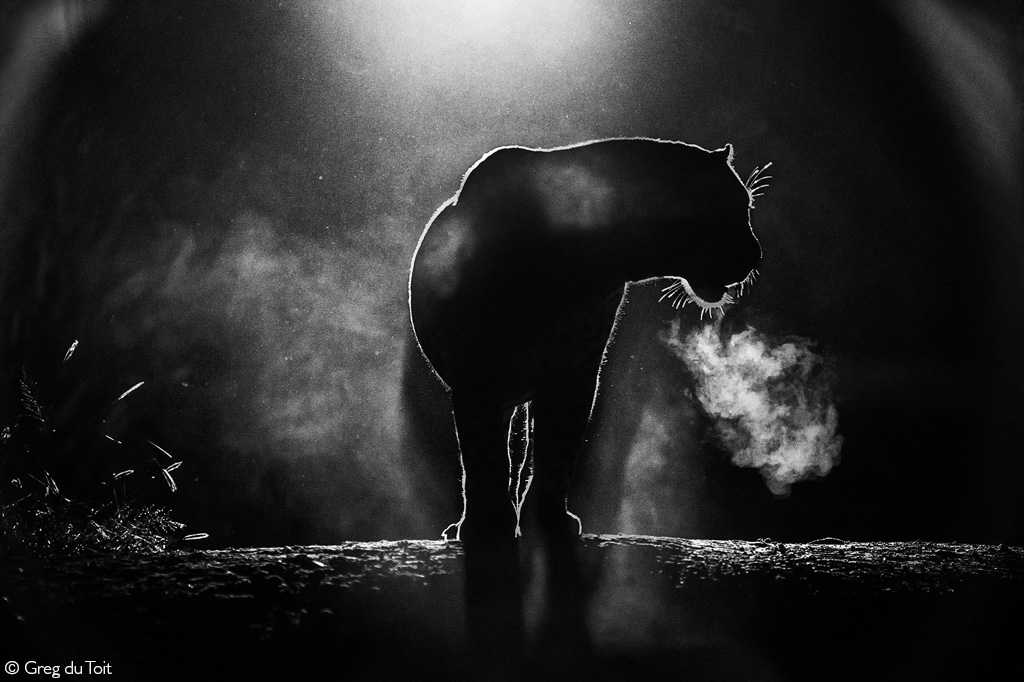
Judges’ comment:
Greg’s capture inspires a sense of awe at the bulk and power of this male leopard as he patrols his territory. The mosaic of multiple elements – dust, water vapour & backlighting – complement each other perfectly to inspire an other-worldly, spiritual feeling in this epic photo. Greg allowed the backlit halo of dust to add a new dimension to his image, rather than detract from it.
Photographer and photo details – read more
Greg says: “It was a cold and nippy night in South Africa’s MalaMala Game Reserve, within Sabi Sands Game Reserve, when our safari guide received a radio call to say that one of the dominant male leopards was on his nightly patrol and heading our way. We pulled off the road slightly, switched off and waited in a dip. It was pitch dark, and it took ages for our subject to appear out of the night. When he finally did, he stood there, a vision before us, his outline made visible by another safari truck’s lights shining from behind. Frantically selecting the correct settings in manual mode and pressing my shutter button, I could only hope that the steam and dust had been recorded in my exposure. Leopards are Africa’s most enigmatic predators, and by silhouetting just the outline and the exhaled breath, I hoped to pay homage to my beautiful and mysterious subject. There are some photographs that you never forget taking – this is one of mine.”
About photographer Greg du Toit
 For over two decades, South African-born Greg du Toit has been solely devoted to photographing Africa’s wildlife. His fine art collections have been shown from New York to Singapore, and his work has hung in natural history museums from Canada to Australia. His solo exhibition, ‘Authentic Africa’, hosted by the National Geographic gallery on London’s Regent Street, was a sell-out. The BBC Wildlife Magazine featured the article, ‘A waiting game’, detailing his 270 hours spent sitting inside a Kenyan waterhole. He is the author of three books: AWE, a coffee-table book containing a decade’s worth of imagery and Getting it right in camera, a how-to book for wildlife photographers. Wilderness dreaming is the title of his African memoir, filled with wild bush adventures in his search of lost Africa. The BBC World Service has interviewed him, he has appeared on NBC’s TODAY show and has, as a guest speaker, delivered presentations as far afield as northern Finland. Through his online galleries, his limited-edition prints bring Africa to the walls of homes worldwide. Greg donates some of his prints to both humanitarian and wildlife charities.
For over two decades, South African-born Greg du Toit has been solely devoted to photographing Africa’s wildlife. His fine art collections have been shown from New York to Singapore, and his work has hung in natural history museums from Canada to Australia. His solo exhibition, ‘Authentic Africa’, hosted by the National Geographic gallery on London’s Regent Street, was a sell-out. The BBC Wildlife Magazine featured the article, ‘A waiting game’, detailing his 270 hours spent sitting inside a Kenyan waterhole. He is the author of three books: AWE, a coffee-table book containing a decade’s worth of imagery and Getting it right in camera, a how-to book for wildlife photographers. Wilderness dreaming is the title of his African memoir, filled with wild bush adventures in his search of lost Africa. The BBC World Service has interviewed him, he has appeared on NBC’s TODAY show and has, as a guest speaker, delivered presentations as far afield as northern Finland. Through his online galleries, his limited-edition prints bring Africa to the walls of homes worldwide. Greg donates some of his prints to both humanitarian and wildlife charities.
Social: wildernessdreaming

HIGHLY COMMENDED
(in no specific order)
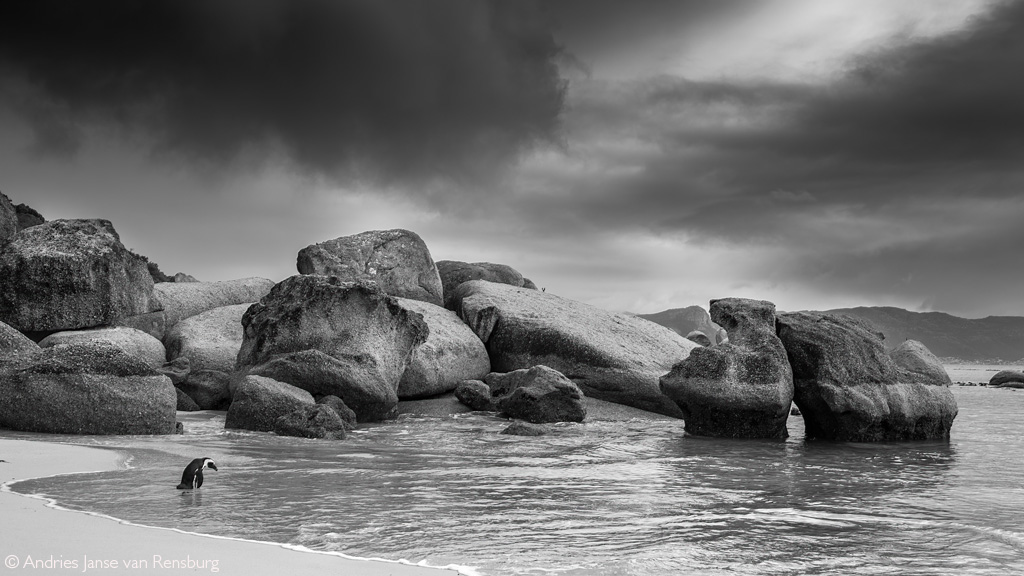
Judges’ comment:
This lonely penguin’s seemingly forlorn posture speaks to the species’ rapidly diminishing status and uncertain future. The choice of black-and-white and moody post-production elements emphasise this uncertainty. The African penguin population is believed to be less than 2% of what it was at the start of the 20th century, and the slide continues. Declining fish stocks drive the reduction of the penguin population – caused by overfishing and climate change-induced warmer water, which drives the fish shoals further away from the penguins’ breeding grounds.
Photo details – read more
Andries says: “On a cold and rainy morning, I visited the penguin colony at Boulders Beach in Simon’s Town, in Cape Town, South Africa. The clouds were dark, and I was the only person on the beach in the SANParks-run area where a colony of African penguins are protected. I walked around with my camera and wide-angle lens in search of that one special moment to capture. I managed to capture a series of images of penguins on the day, but this specific one where the penguin’s bent head seemed to convey grief as if he were the only one left, with no other penguins around, stood out to me. On this dark, cloudy day, the natural decision for me was a black-and-white conversion of the image, which contributes to the story depicted in the scene of an endangered breed alone.”
Social: andriesjvrensburg
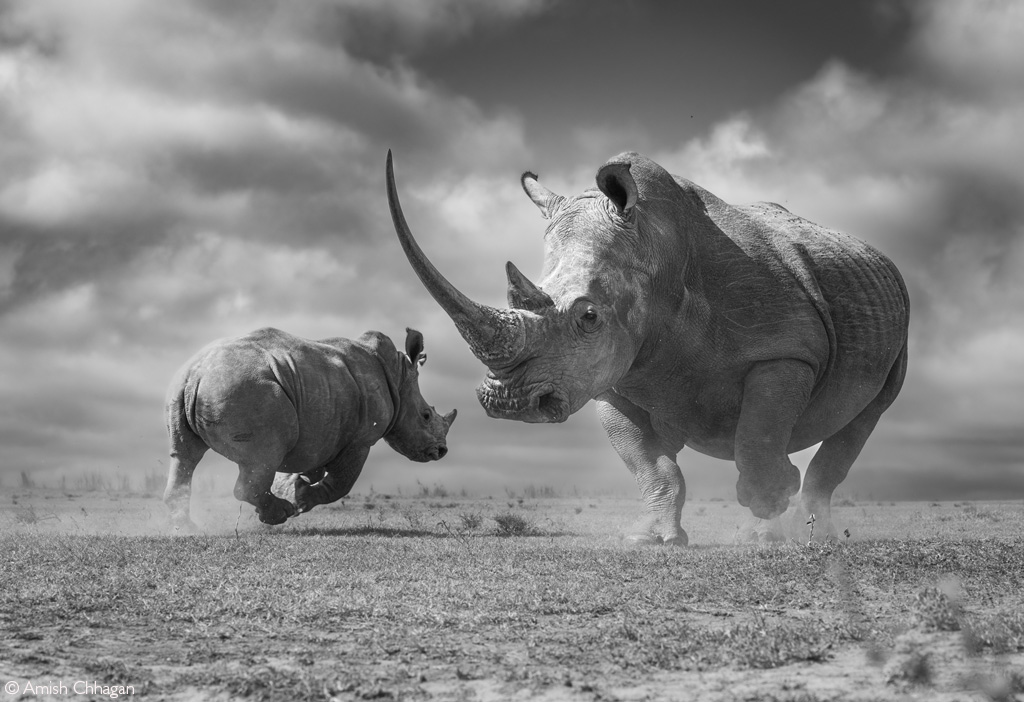
Judges’ comment:
The joyful exuberance of this moment brings a smile to the eyes. So much rhino imagery these days focuses on their status as prime poaching targets, so this happy capture is a breath of fresh air. The sight of a complete set of horns is rare these days, adding to how special this capture is. The lower angle of the shot serves to empower the rhino subject, adding an element of awe and wonderment for these otherwise vulnerable beasts.
Photo details – read more
Amish says: “This photo depicts two southern white rhinos seemingly playing a game of tag. It provides a sense of place that is spacious, free and with no threats. The small rhino running in the back provides an additional layer for the photo. The rhino conservancy where this image was taken plays a central role in rehabilitating the species in East Africa and helps to facilitate reintroduction of rhinos all over Africa. Talk about the recovery of a species!”
Social: chags.photography
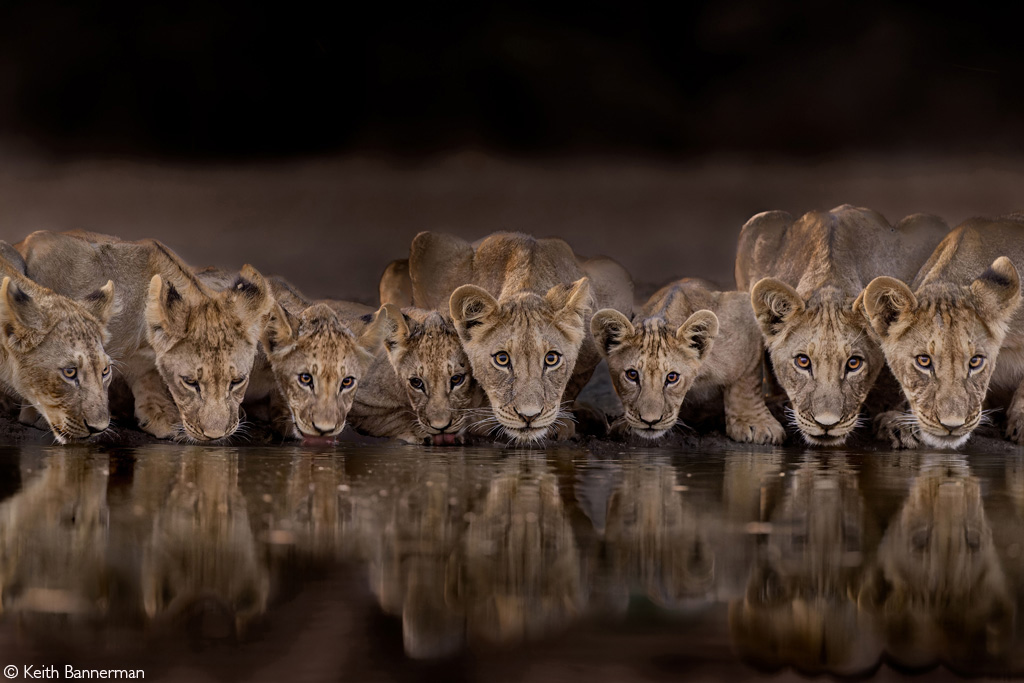
Judges’ comment:
Who does not enjoy a lineup of big cats drinking – especially when they are all facing you? The uncertain, feral look in the eyes of these young lions adds to the sense of rugged wilderness. Keith captured this moment with clarity, despite the challenges of difficult lighting and multiple moving subjects.
Photo details – read more
Keith says: “This shot was taken at Dinaka, at the northern edge of the Central Kalahari Game Reserve, in mid-November, on the last day of a two-week South African safari. The lion pride, including two males, several females and eight cubs, occasionally visited the waterhole where this image was taken. I received information the previous evening that the pride were there and hoped they would still be there in the morning. I set off early, at 5am, before sunrise, with a guide to check it out. The air was still and relatively cool for the time of year. We got to the waterhole in 15 minutes, and to our delight, the pride was still there, all resting at the time. I got my camera set up and waited for the lions to become more active, and it wasn’t long before they started moving, followed by a loud morning call from the pride. That is a sight and sound to behold. Shortly afterwards, the cubs made their way to the water’s edge, looking around whilst they got in position to drink. I was amazed that they all lined up next to each other as if it were rehearsed. It is common to find lions group together when drinking, but cubs tend to have adults with them or do it in smaller groups. So, I was fortunate that all the cubs came together for that moment. This was a challenging shot as the sun still hadn’t risen, and despite the high-low light performance in modern cameras, I had to quickly decide to balance my ISO with a fast enough shutter speed to get a usable shot. My camera was rested on a bean bag, and I was on manual with a 400mm lens at 1/40 sec, F4, with an ISO of 5000. Recognising that this would create some image blur if any of the cubs moved, I trusted that with my camera set at 30 frames-per-second, at least one would be sharp. So I fired away, knowing this was one of those special moments that rarely happen in wildlife photography. When returning to the lodge later that morning, after reviewing the shots I had taken, I was so happy that I had that one sharp image that perfectly captured that magical moment.”
Social: khbimages

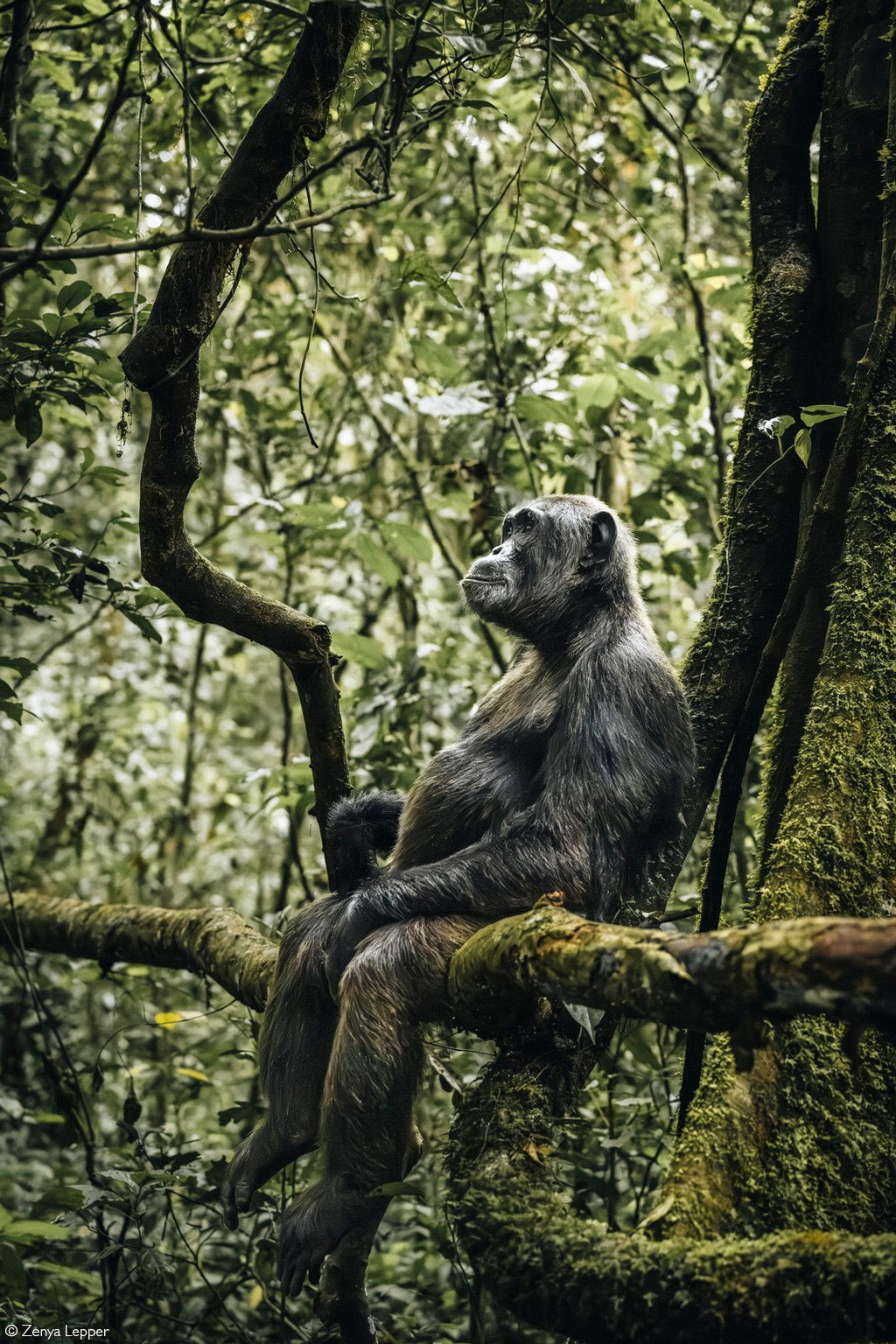
Judges’ comment:
Tea and biscuits, anybody? The likeness to an old gent relaxing in his favourite chair and watching the grandchildren play makes this an endearing capture. Anthropomorphism aside, the pondering gaze emphasises that chimps are our closest relatives. While Zenya also had the opportunity to capture multiple busy chimpanzees in action during her time with the troop, she instead set her focus and attention on this chimp, taking the time to capture this pensive moment.
Photo details – read more
Zenya says: “Walking through the Kibale Forest in Uganda was like stepping into a dream. Where the line between man and animal fades away, and you realise just how similar we are to our close relative, the chimpanzee. When first entering the forest, the only sound was rumbling thunder and crunching leaves under our feet. A chorus of calls split the air, guiding us to the chimpanzees. We picked up our pace, following the new sound that brought the forest to life. Minutes later, we encountered a trio of males sitting on the ground, watching our approach. I was so excited to be with these males, that I didn’t realise we were in the middle of a large family – until my guide tapped me on the shoulder and quietly pointed behind me. My eyes then started to wander and slowly take in my surroundings. This wondrous world soon expanded, showing a mother holding a young baby, adolescents swinging in the trees, napping adults scattered about on the ground, and a chimpanzee sitting on a fallen limb just as a person might sit. I carefully made my way to the sitting chimpanzee, who never shifted or looked in my direction, his gaze transfixed on a distant spot as if lost in a daydream. It is incredible how similar we are to chimpanzees; they watched me as I watched them, communicated with each other as I communicated with my guide, and walked through the forest as I walked through the forest. As the hour ended, I took one last look at the sitting chimpanzee, still lost in thought, and silently thanked the family who had briefly accepted me into their home.”
Social: zenya_lepper
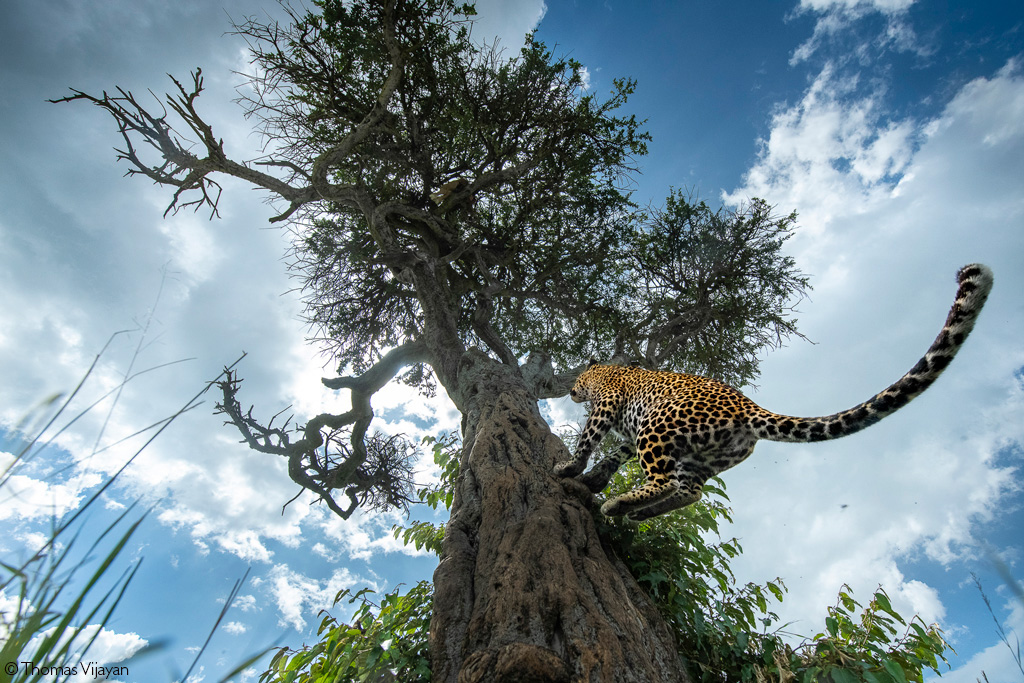
Judges’ comment:
The backstory of planning and patience makes this capture worthy of recognition. And the unusual bottom-up perspective, as this leopard propels itself up the tree, emphasises the power of these big cats. There was plenty that could’ve (and did) go wrong when trying to take this image – from focal points and falling leaves, to the unpredictable habits of the leopard, but Thomas perservered to capture an awesome shot.
Photo details – read more
Thomas says: “Captured during the midday, this striking photograph, taken in Maasai Mara, reveals the exceptional tree-climbing prowess of leopards. Known for their agility in scaling trees, leopards use this skill to safeguard their prey from scavengers and predators and ambush their prey from above. Their robust necks and shoulders enable them to haul prey much heavier than themselves up into the safety of lofty branches. In this scene, I positioned my camera beneath the tree where the leopard had stashed its food, anticipating its return. The setup was fraught with challenges, from the constant threat of dry leaves obscuring the lens to unpredictable elements like rain, and the possibility of the leopard approaching from an unexpected direction. Despite numerous setbacks and failed attempts, perseverance paid off as I finally captured this rare and unique angle of the leopard. The image captures the leopard in a moment of careful inspection, poised amid its strategic behaviour. Its tail balances expertly as it ascends, illustrating the elegance and adaptability of this magnificent predator in its natural environment.”
Social: thomasvijayan

Judges’ comment:
This arresting image bursts through and grabs the eye for its stark portrayal of Mother Nature in all her brutality. The impala’s apparent look of surprise adds to the drama, and the wild dog’s casual gaze emphasises that this is business as usual for any predator (including humanity). Anyone who has spent time with wild dogs knows the frenzy of the hunt and the ensuing feed – which requires constant adjustment and divided attention in choosing the right subject. Michael chose his subject perfectly, while photographing from the best possible angle.
Photo details – read more
Michael says: “A dramatic and rare wildlife moment in South Luangwa National Park, Zambia, on the Kulandila Plain. The impalas and pukus were scattering, indicating the presence of predators. The resident pack of African wild dogs (painted wolves) had successfully hunted down a young impala ram. By the time I reached the action, the wild dogs had consumed most of the impala and were carrying away parts of the carcass. I spotted one dog carrying the impala’s head towards a grassy bank. I strategically positioned the vehicle in a gulley next to the bank, hoping to capture a low-angle shot. Patience is vital, and when a dog finally climbed the bank, I took advantage of a brief but incredible photographic opportunity. It is truly a once-in-a-lifetime sighting, highlighting the unpredictability and excitement of wildlife photography.”
Social: michaeldavyphotography
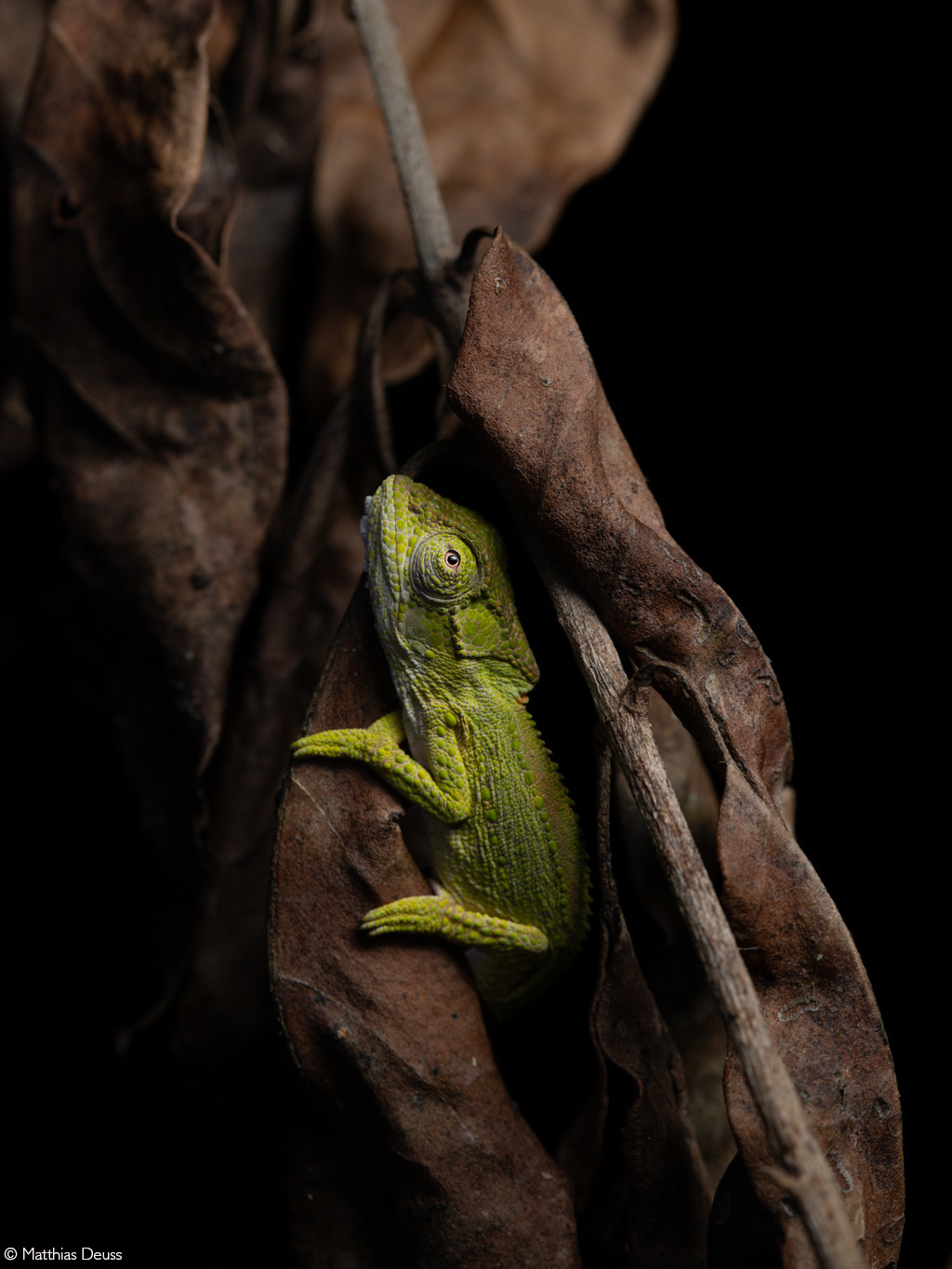
Judges’ comment:
The chameleon’s luminous green contrasts with the dry leaves’ drab brown as it scans the photographer from its nighttime hideaway. Of all the photos in this final stage, this one required the least post-production editing and is the most similar to the raw file version – demonstrating the photographer’s skill in painting with the limited light available.
Photo details – read more
Matthias says: “I found this Knysna dwarf chameleon while nightspotting in Diepwalle Forest, Western Cape, South Africa. I saw a few of them that night, but this young one caught my eye because it had found shelter between two dead leaves. This precarious position and the contrast of colours and textures underlined its vulnerability. Dwarf chameleons are endemic to Southern Africa and comprise twenty species with restricted distributions. The Knysna-Tsitsikamma area holds the largest remnant of afrotemperate forest upon which this chameleon depends.”
Social: matthiasdeussphoto
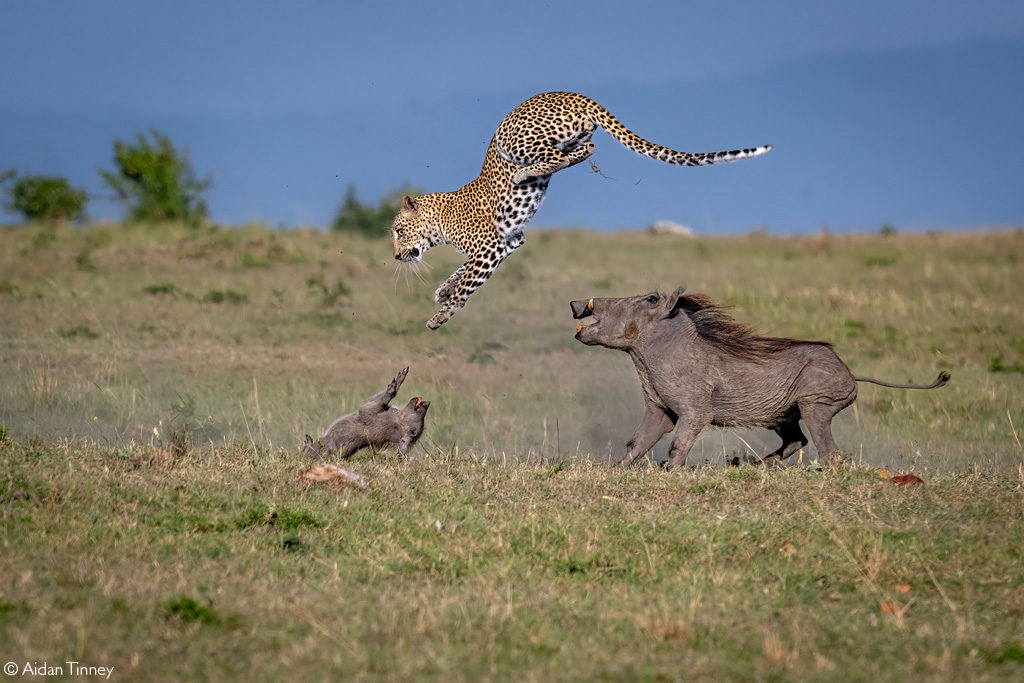
Judges’ comment:
This extraordinary action shot grabs the attention and tells an epic story. Warthogs are formidable gladiators – none more so than a mother. Each of the three combatants shows the moment’s stress in their facial expressions – especially the leopard, which has just been barged into from behind. Capturing the pinnacle of the hunt, with each subject portrayed crisply and clearly, was no mean feat on the photographer’s part.
Photo details – read more
Aidan says: “We had just arrived on the scene when we found that Faulu, a leopard we had been following, was beginning to hunt a family of warthogs. There were three piglets in the family of six warthogs, and Faulu separated them. After initially attempting to run away, the mother warthog’s maternal instincts took over, and she swivelled around to defend her piglet as Faulu was gaining ground on it. Faulu caught the piglet and was in the process of attempting to kill it when the brave mother warthog attacked the right side of Faulu’s pelvis with her tusks. The leopard was caught off guard by the attack as she hadn’t seen the mother and jumped into the air with the wounded piglet flying out of her mouth. As the piglet landed, it scampered under its mother’s body, petrified of Faulu’s oncoming pursuit. The attempt was swiftly abandoned as the furious mother warthog chased the leopard away down the hill, with the other warthogs looking on gleefully. Everybody at the scene was astonished by what we had just witnessed, and even our Maasai guide, John, was quietly muttering, ‘Wow…wow…wow.’ It was an unforgettable magical moment in the Maasai Mara.”
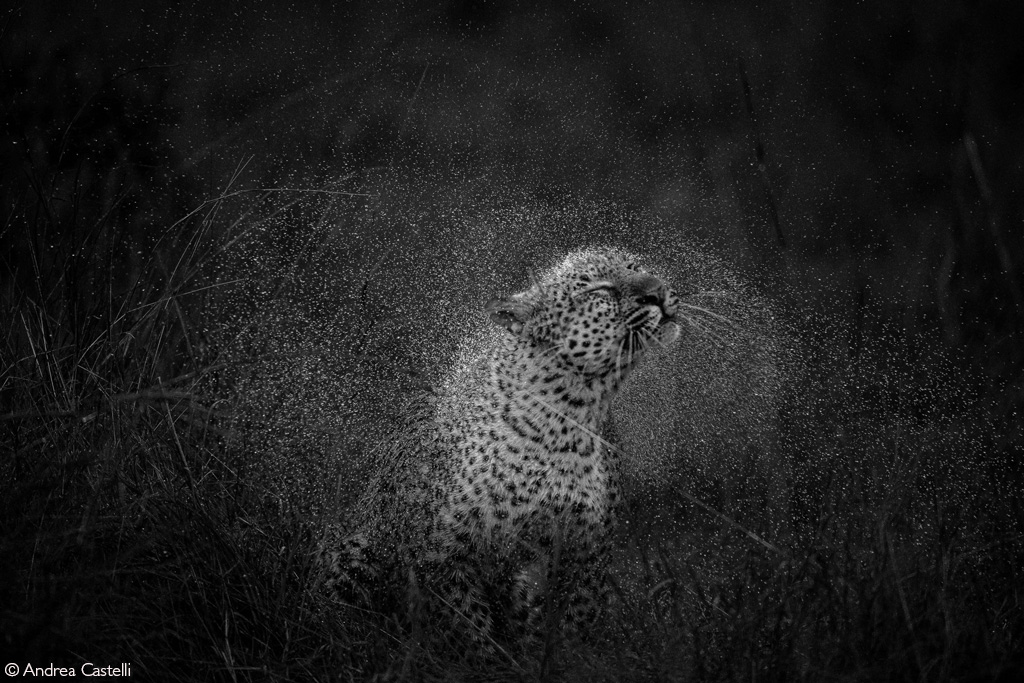
Judges’ comment:
This evocative image resembles last year’s winning photo of a lion shaking off the early morning dew. The choice of black & white adds to the halo impression caused by the movement. Lower lighting following the storm and the leopard’s rapid movement would’ve been challenges for most photographers, but Andrea was able to overcome these to create a remarkable portrait.
Photo details – read more
Andrea says: “Captured in the afternoon following a brief summer shower in Maasai Mara, I captured a majestic leopard shaking off the water from its sleek coat. The composition is framed to showcase the leopard in mid-shake, its powerful muscles and dripping fur frozen in exquisite detail against the lush green backdrop of the savannah. This fleeting moment captures the essence of wild beauty, offering a rare glimpse into the intimate life of one of Africa`s most elusive and iconic predators. The choice of black and white is to emphasise the water droplets forming a circle around the leopard, reminding me of a planet surrounded by the universe.”
Social: ac.wildlife

Judges’ comment:
This stunning capture makes us feel like the prey as this young lion locks onto his target. The photographer found himself in the ideal vantage point to capture a unique view of the stalk, not often shown. The shallow depth of the field contrasts with a sharp focus on the lion’s face to accentuate the effect.
Photo details – read more
Hannes says: “A young lion, full of ambition and hunger, faces a daunting challenge that stands in the way of his success as a predator. Despite his best efforts, his lack of experience is a significant obstacle in his attempt to stalk a herd of gemsbok. His youthful exuberance and determination are not enough to compensate for his inexperience, which becomes evident as the gemsbok quickly detects his approach long before he emerges over the dune. The primary giveaway is his scant, fluffy mane, a telltale sign of his youth and inexperience. This small tuft of fur on his head betrays his presence to the vigilant gemsbok – antelopes that are always looking for potential threats. As a result, the gemsbok can spot him from a distance, well before his eyes even break the horizon. This premature detection prevents the young lion from getting close to his intended prey, leaving him frustrated and hungry. For this aspiring hunter, the growth of his mane is not just a matter of appearance but a crucial factor in his ability to conduct a successful ambush. A fully developed mane cascading down the sides of his head would help him blend into his surroundings more effectively, providing the necessary camouflage to approach his prey undetected. This natural progression in his physical development is essential for his transformation into a skilled and effective predator. This experience serves as a pivotal lesson for the young lion. He learns that patience and time are as important as ambition and energy. The evolution of his mane represents a significant step in his journey towards becoming a proficient hunter. As he matures and his mane grows, he will gain the tools and experience to succeed in the wild. This critical lesson underscores the importance of growth and development in the life of a predator, reminding the young lion that each challenge he faces is a stepping stone towards achieving his ultimate goal of mastering the art of the hunt.”
Social: hannes_lochner

Judges’ comment:
The backlit cub and soft colours accentuate the moment’s tenderness as this lioness carries her cub to safety, and the tight crop emphasises the moment’s intimacy. This is a beautiful capture, accentuated by the styling choices made by the photographer.
Photo details – read more
Irena says: “This was taken in the breathtaking landscape of Ngorongoro, Tanzania, during a nature photography expedition. We witnessed the lioness’s unwavering commitment to her offspring, showing that even the most powerful creatures possess an innate capacity for tenderness and love. This photograph captures a rare and intimate wildlife moment and serves as a metaphor for the strength and gentleness that coexist within all of us. As a mother of two young boys, this moment struck a deep chord within me, evoking a profound sense of connection and empathy. ”
Social: @_irenaor_

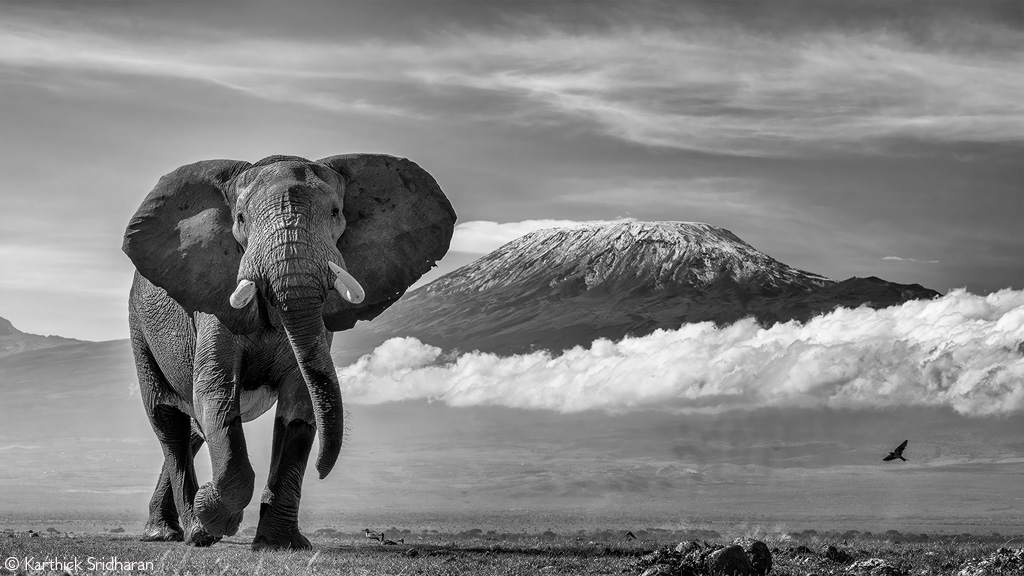
Judges’ comment:
We receive many photo entries of Amboseli’s giants with Mount Kilimanjaro looming in the background, so it takes a really special version of this photograph to capture our imaginations. The eye-level perspective in Karthick’s image emphasises this giant elephant in his domain, and the low clouds and snow-capped Kili peaking out above, as well as the bird inflight, all add to the sense of drama. Add to this the choice of black and white, and the angle of the elephant’s gaze, and you have an excellent capture.
Photo details – read more
Karthick says: “Amboseli National Park is a haven for wildlife, making it a prime spot for photography. Amboseli is known for its large elephant population, many of which are often photographed with Mount Kilimanjaro in the background. I dreamed of capturing an elephant with Mount Kilimanjaro in the background on every visit to the area. Usually, one was visible, but not the other. This hide-and-seek went on for years. On the day this photograph was taken, I felt like God smiled on me. One peaceful morning, my dream came true. A majestic elephant walked towards me with elegance. The tusker stood prominently as Mount Kilimanjaro loomed behind, its snow-capped peak piercing the azure sky. Clouds hung halfway, adding mystery. Nature’s grandeur was captured in a fleeting moment. I stayed calm, knowing I had only seconds before the elephant moved on. Looking through my camera, I cherished the view. The juxtaposition of the elephant against Mount Kilimanjaro was powerful and peaceful. In that instant, I felt a profound bond with nature. This picture speaks volumes about Amboseli’s beauty and wildlife, showcasing an extraordinary perspective and stunning scenery.
Social: karthicksphotography
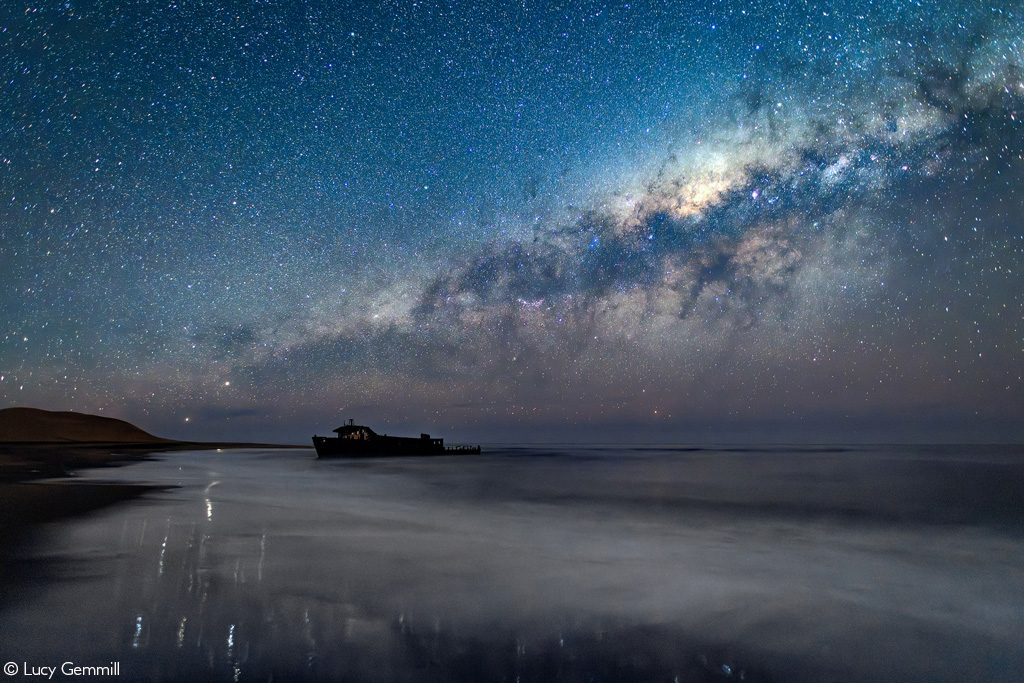
Judges’ comment:
We can all imagine ourselves setting up this capture with our toes in the cold Atlantic Ocean waters and that endless night sky beckoning. That sense of being drawn into the experience makes this a great image. While we receive many photos capturing the Milky Way, this photo, with its silky waters, the stars reflecting on the water, and the added apparition of the Shawnee shipwreck that seems to be aglow on the inside, is an epic shot.
Photo details – read more
Lucy says: “Last year in July, some friends and I went wild camping along the Namibian skeleton coast for six days. I love wild camping, as one can get to the most remote places and see not too many people. We made camp on the dunes way above the Shawnee shipwreck. It’s remarkable how high some of these dunes are. My friends and I all went down to the shore with our cameras, tripods and lack of shoes. The sand was beautifully warm from the last of the sun’s rays. The Atlantic Ocean, on the other hand, was utterly freezing. I was unsure how my feet would cope later that night, as we decided that we would paddle into the water to take images of the Shawnee wreck with the Milky Way and billions of twinkling stars reflecting in the wet sand. I woke up at 2am and walked carefully down to the shoreline. The sky was void of clouds and there was not even a hint of sea mist. Funnily enough, the ocean temperature wasn’t as Baltic as I thought it would be. The tide was slowly coming in. I managed to capture one of my most beloved images that morning, with the reflection of the stars in the wet sand as the waves were pulling in and out and the Milky Way hung over the Shawnee wreck. While on the slow walk back up to the campfire, and later while defrosting my feet whilst sipping my first cup of coffee of the day, I appreciated every second of how lucky I was to experience this. I look forward to my next adventure!”
Social: shutterbug_girl

Judges’ comment:
This evocative image transports us all to a moment of quiet contemplation, no matter our choice of spiritual comfort. The moment transcends all belief systems and religions to speak to our inner soul. The moody highlighting of the Hieroglyphs add to the sense of passing time and fleeting history, and the photographer’s choice of subject help us to envision ourselves in this sacred space.
Photo details – read more
Rachelle says: “An overnight train and sunrise boat across the Nile had me standing at the gates of Karnak Temple in Luxor, Egypt. I stared in awe as I entered a true wonder of the world. Workers and guides started arriving, and we all started our day in silence. I soon found myself engulfed in a grand hall of magnificently massive columns, lavishly decorated in carvings and hard to comprehend. A smiling man appeared, and I couldn’t help but notice that everyone had gone out of their way to greet and chat him up. I could see why; his energy was grand, and he seemed a master of this environment. I introduced myself and explained my quest. I was here to work on a project about Egypt and showed him a portfolio of my work. He loved the work, and we shared a lot of kind words. Setting off, we were soon deep in a maze of unbelievable wonder. Mahmoud was his name, and he had worked here for over 50 years. He started as a young boy working alongside his father, a man who also spent his life here at Karnak. Mahmoud has spent his entire life working here, surrounded by secrets and ancient artefacts; how could I be so lucky to become friends with him? We walked and talked as he imparted knowledge and pointed out ancient feats of human achievement. But, when we entered a temple on the far side of the complex, we shared what I can only call a spiritual experience. We entered a closed room; I was greeted by deafening silence and the smell of sand. A singular beam of light sliced through the darkness and illuminated a portion of the room. Thousands of years after this temple was built, I stood there as the unknown viewer, gazing at the hand of the unknown artist. It was breathtaking. He told me that, throughout the day, different parts of the room were revealed. I was awestruck. He cupped the light beam with his hands, and I captured his portrait. The moment was brief as we soon had to leave; very few people were allowed in this room. As we walked away, I understood how lucky I was; his contribution to my project, ‘Winds of the Nile’, would be something I would need to ponder for many years.”
Social: steelecapture
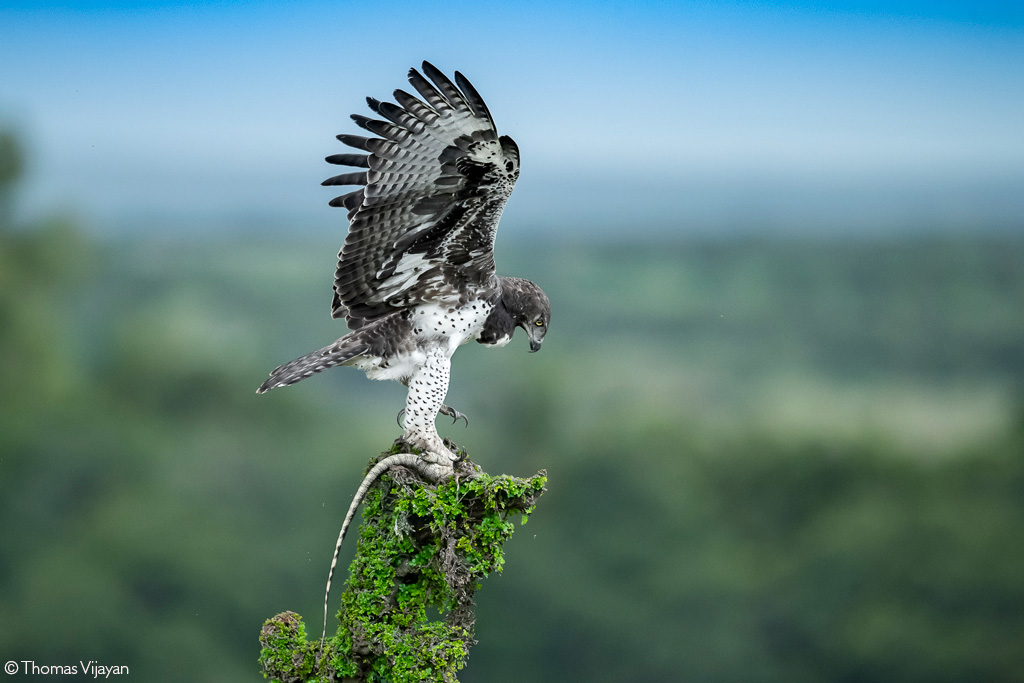
Judges’ comment:
The shallow depth of field and sharp focus seem to transport the tussle between the eagle and prey to that critical moment when all else stands still, and all that matters is what is happening right here, right now. Capturing a moment like this at eye-level is a rare opportunity, that was expertly seized by the photographer.
Photo details – read more
Thomas says: “In this captivating image, a martial eagle dominates the scene as it captures and kills a leguaan. Initially focused on photographing lions, I spotted the eagle in the distance, its wings unfurled in a dramatic display. Intrigued, I approached and realised it was amidst a fierce hunt. The martial eagle, Africa’s largest eagle, is an imposing creature known for its strength. With a wingspan reaching over 2m and weighing nearly 6.5kg, it possesses formidable power and is capable of astonishing feats like breaking bones with its talons. Its dark brown upperparts contrast sharply with a white belly adorned with black streaks, while its legs are white with enormous talons that ensure its prowess in hunting. In this shot, the eagle’s wings are fully extended, showcasing its impressive size and the moment’s intensity. The posture of the eagle exudes a sense of triumph, capturing the essence of its victorious battle with the monitor lizard.”
Social: thomasvijayan
To comment on this story: Login (or sign up) to our app here - it's a troll-free safe place 🙂.![]()

